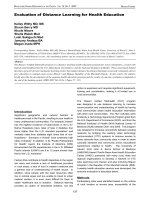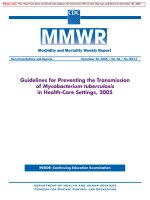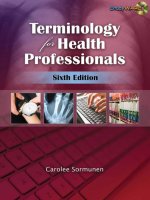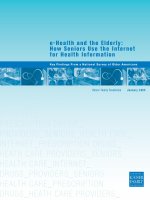MEDICAL TERMINOLOGY FOR HEALTH PROFESSIONS Sixth Edition pot
Bạn đang xem bản rút gọn của tài liệu. Xem và tải ngay bản đầy đủ của tài liệu tại đây (29.98 MB, 636 trang )
MEDICAL
TERMINOLOGY
FOR HEALTH PROFESSIONS
Sixth Edition
This page intentionally left blank
ANN EHRLICH
CAROL L. SCHROEDER
MEDICAL
TERMINOLOGY
FOR HEALTH PROFESSIONS
Sixth Edition
Australia Brazil Japan Korea Mexico Singapore Spain United Kingdom United States
Medical Terminology for Health Professions,
Sixth Edition
by Ann Ehrlich and Carol L. Schroeder
Vice President, Career
and Professional Editorial: Dave Garza
Director of Learning Solutions: Matthew Kane
Acquisitions Editor: Matthew Seeley
Managing Editor: Marah Bellegarde
Editorial Assistant: Megan Tarquinio
Senior Product Manager: Debra Myette-Flis
Vice President, Career and Professional Marketing:
Jennifer McAvey
Senior Marketing Manager: Michele C. McTighe
Production Director: Carolyn S. Miller
Senior Content Project Manager: James Zayicek
Senior Art Director: Jack Pendleton
Technology Project Manager: Benjamin Knapp
Printed in United States of America
12345XXX1211100908
COPYRIGHT © 2009, Delmar Cengage Learning
ALL RIGHTS RESERVED. No part of this work covered by the copyright
hereon may be reproduced or used in any form or by any means—graphic,
electronic, or mechanical, including photocopying, recording, taping, Web
distribution or information storage and retrieval systems—without the
written permission of the publisher.
Library of Congress Control Number: 2008922083
ISBN-13: 978-1-4180-7252-0
ISBN-10: 1-4180-7252-4
Delmar Cengage Learning
5 Maxwell Drive
Clifton Park, NY 12065-2919
USA
Cengage Learning Products are represented in Canada by Nelson
Education. Ltd.
For your lifelong learning solutions, delmar.cengage.com
Visit our corporate web site at cengage.com
NOTICE TO THE READER
Publisher does not warrant or guarantee any of the products described herein or
perform any independent analysis in connection with any of the product
information contained herein. Publisher does not assume, and expressly disclaims,
any obligation to obtain and include information other than that provided to it by
the manufacturer.
The reader is expressly warned to consider and adopt all safety precautions that
might be indicated by the activities described herein and to avoid all potential
hazards. By following the instructions contained herein, the reader willingly assumes
all risks in connection with such instructions.
The publisher makes no representations or warranties of any kind, including but
not limited to, the warranties of fitness for particular purpose or merchantability,
nor are any such representations implied with respect to the material set forth
herein, and the publisher takes no responsibility with respect to such material. The
publisher shall not be liable for any special, consequential, or exemplary damages
resulting, in whole or part, from the reader’s use of, or reliance upon, this material.
For product information and technology assistance, contact us at
Cengage Learning Academic Resource Center, 1-800-423-9706
For permission to use material from this text or product, submit all
requests online at cengage.com/permissions.
Further permissions questions can be e-mailed to
Contents
Preface xiii
To the Learner / xiii
To the Instructor / xv
Acknowledgments / xxi
How to Use This Book / xxii
How to Use StudyWARE
™
/ xxv
Chapter 1: Introduction to Medical
Terminology 1
Overview of Introduction to Medical Terminology / 1
Vocabulary Related to the Introduc tion to Medical Terminology / 2
Primary Medical Terms / 3
Word Parts Are the Key / 3
Word Roots / 4
Suffixes / 4
Prefixes / 7
Determining Meanings on the Basis of Word Parts / 8
Medical Dictionary Use / 9
Pronunciation / 10
Spelling Is Always Important / 11
Using Abbreviatio ns / 11
Singular and Plural Endings / 11
Basic Medical Terms to Describe Diseases / 11
Look-Alike Sound-Alike Terms and Word Parts / 11
Abbreviations Related to the Introduction to Medical Terminology / 15
Learning Exercises / 16
The Human Touch: Critical Thinking Exercise / 25
Chapter 2: The Human Body in Health
and Disease 26
Overview of the Human Body in Health and Disease / 26
Vocabulary Related to the Human Body in Health and Disease / 27
Anatomic Reference Systems / 28
Structures of the Body / 34
Cells / 34
Genetics / 35
Tissues / 37
Glands / 38
Body Systems and Related Organs / 39
Pathology / 39
Aging / 41
Abbreviations Related to the Human Body in Health and Disease / 41
Learning Exercises / 42
The Human Touch: Critical Thinking Exercise / 51
PRE
(before)
NAT AL
(birth)
+
v
Word Part Review 52
Word Part Practice Session / 52
Word Part Post-Test / 55
Chapter 3: The Skeletal System 58
Overview of Structures, Combining Forms, and Functions
of the Skeletal System / 58
Vocabulary Related to the Skeletal System / 59
Structures and Functions of the Skeletal System / 60
The Structure of Bones / 60
Joints / 61
The Skeleton / 63
Medical Specialties Related to the Skeletal System / 71
Pathology of the Skeletal System / 72
Diagnostic Procedures of the Skeletal System / 78
Treatment Procedures of the Skeletal System / 78
Abbreviations Related to the Skeletal System / 82
Learning Exercises / 84
The Human Touch: Critical Thinking Exercise / 93
Chapter 4: The Muscular System 94
Overview of Structures, Combining Forms, and Functions
of the Muscular System / 94
Vocabulary Related to the Muscular System / 95
Functions of the Muscular System / 96
Structures of the Muscular System / 96
Types of Muscle Tissue / 96
Muscle Contraction and Relaxation / 98
Contrasting Muscle Motion / 99
How Muscles Are Named / 101
Medical Specialties Related to the Muscular System / 102
Pathology of the Muscular System / 102
Diagnostic Procedures of the Muscular System / 110
Treatment Procedures of the Muscular System / 111
Abbreviations Related to the Muscular System / 112
Learning Exercises / 114
The Human Touch: Critical Thinking Exercise / 123
Chapter 5: The Cardiovascular System 124
Overview of Structures, Combining Forms, and Functions of the
Cardiovascular System / 124
Vocabulary Related to the Cardiovascular System / 125
Functions of the Cardiovascular System / 126
Structures of the Cardiovascular System / 126
vi
The Blood Vessels / 131
Blood / 134
Medical Specialties Related to the Cardiovascular System / 136
Pathology of the Cardiovascular System / 136
Diagnostic Procedur es of the Cardiovascular System / 145
Treatment Procedures of the Cardiovascular System / 146
Abbreviations Related to the Cardiovascular System / 150
Learning Exercises / 151
The Human Touch: Critical Thinking Exercise / 160
Chapter 6: The Lymphatic and Immune
Systems 161
Overview of Structures, Combining Forms, and Functions of the
Lymphatic and Immune Systems / 161
Vocabulary Related to the Lymphatic and Immune Systems / 162
Introduction / 163
Medical Specialties Related to the Lymphatic and
Immune Systems/163
Functions of the Lymphatic System / 163
Structures of the Lymphatic System / 163
Functions and Structures of the Immune System / 168
Pathogenic Organi sms / 174
Oncology / 176
Abbreviations Related to the Lymphatic and Immune Systems / 181
Learning Exercises / 183
The Human Touch: Critical Thinking Exercise / 192
Chapter 7: The Respiratory System 193
Overview of Structures, Combining Forms, and Functions of the
Respiratory System / 193
Vocabulary Related to the Respiratory System / 194
Functions of the Respiratory System / 195
Structures of the Respiratory System / 195
Respiration / 199
Medical Specialties Related to the Respiratory System / 201
Pathology of the Respiratory System / 201
Diagnostic Procedur es of the Respiratory System / 209
Treatment Procedures of the Respiratory System / 210
Abbreviations Related to the Respiratory System / 212
Learning Exercises / 214
The Human Touch: Critical Thinking Exercise / 223
vii
Chapter 8: The Digestive System 224
Overview of Structures, Combining Forms, and Functions
of the Digestive System / 224
Vocabulary Related to the Digestive System / 225
Structures of the Digestive System / 226
Digestion / 233
Medical Specialties Related to the Digestive System / 234
Pathology of the Digestive System / 234
Diagnostic Procedures of the Digestive System / 243
Treatment Procedures of the Digestive System / 244
Abbreviations Related to the Digestive System / 246
Learning Exercises / 248
The Human Touch: Critical Thinking Exercise / 257
Chapter 9: The Urinary System 258
Overview of Structures, Combining Forms, and Functions of the
Urinary System/258
Vocabulary Related to the Urinary System / 259
Functions of the Urinary System / 260
Structures of the Urinary System / 260
The Excretion of Urine / 262
Medical Specialties Related to the Urinary System / 262
Pathology of the Urinary System / 263
Diagnostic Procedures of the Urinary System / 268
Treatment Procedures of the Urinary System / 270
Abbreviations Related to the Urinary System / 274
Learning Exercises / 275
The Human Touch: Critical Thinking Exercise / 284
Chapter 10: The Nervous System 285
Overview of Structures, Combining Forms, and Functions of the
Nervous System / 285
Vocabulary Related to the Nervous System / 286
Functions of the Nervous System / 287
Structures of the Nervous System / 287
The Central Nervous System / 290
The Peripheral Nervous System / 295
The Autonomic Nervous System / 296
Medical Specialties Related to the Nervous System / 296
Pathology of the Nervous System / 297
Diagnostic Procedures of the Nervous System / 304
Treatment Procedures of the Nervous System / 304
Mental Health / 305
Abbreviations Related to the Nervous System / 309
Learning Exercises / 310
The Human Touch: Critical Thinking Exercise / 319
viii
Chapter 11: Special Senses: The Eyes
and Ears 320
Overview of Structures, Combining Forms, and Functions
of the Eyes and Ears / 320
Vocabulary Related to the Special Senses / 321
Functions of the Eyes / 322
Structures of the Eyes / 322
Medical Specialties Related to the Eyes / 326
Pathology of the Eyes and Vision / 326
Diagnostic Procedur es of the Eyes and Vision / 331
Treatment Procedures of the Eyes and Vision / 331
Functions of the Ears / 333
Structures of the Ears / 333
Medical Specialties Related to the Ears / 335
Pathology of the Ears and Hearing / 335
Diagnostic Procedur es of the Ears and Hearing / 336
Treatment Procedures of the Ears and Hearing / 337
Abbreviations Related to the Special Senses / 338
Learning Exercises / 340
The Human Touch: Critical Thinking Exercise / 349
Chapter 12: Skin: The Integumentary
System 350
Overview of Structures, Combining Forms, and Functions
of the Integumentary System / 350
Vocabulary Related to the Integumentary System / 351
Functions of the Integumentary System / 352
Structures of the Skin and Its Related Structures / 352
Medical Specialties Related to the Integumentary System / 355
Pathology of the Integumentary System / 355
Diagnostic Procedur es of the Integumentary System / 364
Treatment Procedures of the Integumentary System / 365
Abbreviations Related to the Integumentary System / 367
Learning Exercises / 368
The Human Touch: Critical Thinking Exercise / 377
Chapter 13: The Endocrine System 378
Overview of Structures, Combining Forms, and Functions of the
Endocrine System / 378
Vocabulary Related to the Endocrine System / 379
Functions of the Endocrine System / 380
Structures of the Endocrine System / 380
Medical Specialties Related to the Endocrine System / 382
ix
Pathology of the Endocrine System / 383
The Pituitary Gland / 383
The Pineal Gland / 385
The Thyroid Gland / 385
The Parathyroid Glands / 387
The Thymus / 387
The Pancreatic Islets / 388
The Adrenal Glands / 391
The Gonads / 392
Abbreviations Related to the Endocrine System / 394
Learning Exercises / 395
The Human Touch: Critical Thinking Exercise / 404
Chapter 14: The Reproductive Systems 405
Overview of Structures, Combining Forms, and Functions of
the Reproductive Systems / 405
Vocabulary Related to the Reproductive Systems / 406
Terms Related to the Reproductive Systems of Both the Sexes / 407
Functions of the Male Reproductive System / 407
Structures of the Male Reproductive System / 407
Medical Specialties Related to the Male Reproductive System / 409
Pathology of the Male Reproductive System / 409
Diagnostic Procedures of the Male Reproductive System / 411
Treatment Procedures of the Male Reproductive System / 411
Sexually Transmitted Diseases / 412
Functions of the Female Reproductive System / 413
Structures of the Female Reproductive System / 413
Medical Specialties Related to the Female Reproductive System
and Childbirth / 416
Pathology of the Female Reproductive System / 417
Diagnostic Procedures of the Female Reproductive System / 419
Treatment Procedures of the Female Reproductive System / 420
Pregnancy and Childbirth / 422
Pathology of Pregnancy and Childbirth / 425
Assisted Reproduction / 427
Abbreviations Related to the Reproductive Systems / 427
Learning Exercises / 429
The Human Touch: Critical Thinking Exercise / 439
Chapter 15: Diagnostic Procedures
and Pharmacology 440
Overview of Diagnostic Procedures and Pharmacology / 440
Vocabulary Related to Diagnostic Procedures and Pharmacology / 441
Basic Examination Procedures / 442
Basic Examination Positions / 445
Laboratory Tests / 446
x
Endoscopy / 450
Centesis / 451
Imaging Techniques / 451
Pharmacology / 457
Abbreviations Related to Diagnostic Procedures and Pharmacology / 461
Learning Exercises / 462
The Human Touch: Critical Thinking Exercise / 472
Comprehensive Medical Terminology
Review 473
Overview of Comprehensive Medical Terminology Review / 473
Study Tips / 474
Review Session / 477
Simulated Final Test / 487
Appendix A: Prefixes, Combining Forms, and Suffixes / 497
Appendix B: Abbreviations and Their Meanings / 515
Index / 533
Flash Cards / 582
PYR/O
fever, fire
xi
This page intentionally left blank
Preface
n TO THE LEARNER
Welcome to the world of medical terminology! Learning this special language is an
important step in preparing for your career as a health care professional. Here’s
good news: Learning medical terms is much easier than learning a foreign language
because you are already familiar with quite a few of the words—such as appendicitis
and tonsillectomy. Understanding new words becomes easier with the discovery that
many of these terms are made up of interchangeable word parts that are used in
different combinations. Once you understand this, you’ll be well on your way to
translating even the most difficult medical terms, including words you have never
seen before. You’ll be amazed to see how quickly your vocabulary will grow!
This book, and the accompanying teaching materials, are designed to make the
process as simple as possible. Review the introductory sections at the beginning of
the book, including “How to Use This Book” and “How to Use StudyWARE
™
,” so
you can find your way around easily. Once you get comfortable with the format,
you’ll discover you are learning faster than you ever imagined possible.
CHAPTER ORGANIZATION
The text is designed to help you master the medical terminology. It is organized into
15 chapters, a Word Part Review, a Comprehensive Review Section, two appendices,
an index, and removable flash cards. To gain the most benefit from your use of this
text, take adv antage of the many features, including the “Learning Exercises” plus
the “Human Touch” stories and discussion that are included at the end of each
chapter.
Each chapter begins with a vocabulary list consisting of 15 word parts and 60
medical terms selected from amon g the primary terms in the chapter. These
important words are pronounced on the StudyWARE
™
CD-ROM, as well as on the
optional Audio CDs.
Primary terms are the most important terms in a chapter. When first
introduced, the term appears in boldface and, if appropriate, is followed by the
“sounds-like pronunciation.” Only primary terms are used as correct answers in the
exercises and tests.
Secondary terms appear in orange italics. These terms, which are included to
clarify the meaning of a primary term, are used as distracters, but not as correct
answers, in exercises or tests.
Introductory Chapters and Word Part Review
Chapters 1 and 2 create the foundation that enables you to master the rest of the
book. Chapter 1 introduces key word parts—the building blocks of most medical
terms. Chapter 2 introduces more word parts and provides an overv iew of basic
terms used throughout the health field.
xiii
After studying these chapters, complete the Word Part Review that follows Chapter 2. These
practice activities and the accompanying test will help you determine whether you’ve mastered
the concept of these all-important building blocks. If you are having trouble here, it is important
to put more effort into learning these basics.
Body System Chapters
Chapters 3 through 14 are organized by body system. Because each body system stands alone,
you can study these chapters in any sequence. Each chapter begins with an overview of the
structures and functions of that system so you can relate these to the specialists, pathology,
diagnostics, and treatment procedures that follow.
Chapter 15 introduces basic diagnostic procedures, examination positions, imaging techniques,
laboratory tests, and pharmacology. This chapter can be studied at any point in the c ourse.
Comprehensive Medical Terminology Review
This section, which follows Chapter 15, is designed to help you prepare for your final
examination. It includes study tips, practice exercises, and a simulated final test; however, be
aware that none of these questions are from the actual final test.
Appendices
Appendix A: Prefixes, Combining Forms, and Suffixes is a convenient alphabetic reference for
medical word parts. When you don’t recognize a word part, you can look it up here.
Appendix B: Abbreviations and Their Meanings is an extensive list of commonly used
abbreviations and their meanings. Abbreviations are important in medicine and using them
accurately is essential!
LEARNING SUPPLEMENTS
The following supplements are included with your textbook to
provide even more help as you study.
n Flash Cards. Improve your knowledge and test your mastery by
using the flashcards created from the cards provided in the last
section of the book. Remove these perforated pages carefully and
then separate the cards. Flash cards are an effective study aid for use
even when you only have a small amount of time.
n StudyWARE
™
CD-ROM. This interactive software packaged with the
book offers an exciting way to gain additional practice (while having fun) through exerci ses,
game activities, and audio for each chapter. See “How to Use StudyWARE
™
” on page xxv for
details.
PYR/O
fever, fire
xiv PREFACE
n TO THE INSTRUCTOR
From the very first edition, Medical Terminology for Health Professions has been dedicated to
breaking new ground that will make learning medical terminology faster and easier. In this sixth
edition, the authors have maintained this standard of providing high-quality teaching materials
for the mastery of medical terminology.
In the preparation of the sixth edition, all medical term definitions and illustrations have
been reviewed and updated as appropriate. To continue the emphasis on including up-to-date
information, 75 new medical terms have been added. To prevent student overload, obsolete
terms have been deleted or are now shown as secondary terms that students are not required to
memorize.
The changes in this new edition can easily be incorporated into your lesson plans with the
help of the “Correlation Guide” found on the Electronic Clas sroom Manager CD-ROM.
NEW FEATURES IN THE SIXTH EDITION
An exciting new feature has been added to this sixth edition to provide even greater flexibility
for instructors and to make learning easier fo r students.
Introducing the Simplified Syllabus
In response to the needs of those instructors who face the challenge of teaching a “brief”
medical terminology course, the authors have developed a new feature titled “The Simplified
Syllabus.” By using these specialized teaching materials, which are based only on the 60 terms
and 15 word parts from the vocabulary list for each chapter, you can hold your students
responsible only for this key information. These materials include:
n A Simplified Syllabus Workbook with written questions plus, just for fun, a crossword puzzle
at the end of each chapter. This workbook is designed to provide students with additional
practice in working with the terms they are learning.
n A Simplified Syllabus Computerized Test Bank with questions using these key terms and
word parts for each chapter plus a midterm and final test.
n Simplified Syllabus Activities are included in the Instructors Manual, which is part of the
Electronic Classroom Manager CD-ROM.
n Audio CDs feature all of the Simplified Syllabus terms pronounced and defined. This creates a
flexible study aid for use by your students. (For details, see Audio CDs below.)
SPECIAL RESOURCES TO ACCOMPANY THE BOOK
Audio CDs
The Audio CDs include the pronunciation of the 60 terms from the vocabulary list for each
chapter. After a pause, the word is pronounced again and then defined. These Audio CDs are a
valuable, flexible learning aid for use whenever and wherever the learner needs to study.
Three Audio CDs, ISBN 1-4180-7258-3
PREFACE xv
The Electronic Classroom Manager
The Electronic Classroom Manager is a robust computerized tool for your instructional needs! A
must-have for all instructors, this comprehensive and convenient CD-ROM contains:
n Textbook Teaching Resources is an overview of the teaching resource featured in the text.
n Conversion Guide helps you make the change from the fifth to the sixth edition of Medical
Terminology for Health Professions.
n Textbook Learning Exercises Answer Keys are arranged for ease of printing, with one chapter
per page.
n Workbook Answer Keys are also included.
n Exam View
®
Computerized Testbank contains two banks of prepared questions: The
Standard Tests include 100 questions per chapter plus a 50-question midterm test that covers
Chapters 1 through 8, and a 100-question final test covering the entire text. The Simplified
Syllabus test bank includes 75 questions per chapter plus a 50-question midterm test that
covers Chapters 1 through 8, and a 100-question final test covering the entire text. You can use
these questions to create your own review materials or tests. This versatile program enables you
to create your own tests and to write additional questions.
n PowerPoint Presentations, including animations, are designed to aid you in planning your
class presentations. If a learner misses a class, a printout of the slides for a lecture makes a
helpful review page. To facilitate correcting Learning Exercises in class, answer keys are
included in the PowerPoint
®
slides.
n The Instructor’s Manual includes a wide variety of valuable resources to help you plan the
course and implement activities by chapter. The availability of this manual in an electronic
format increases its value as a teaching resource. This manual includes:
n Course Planning Tips, including a sample 16-week syllabus and a sample course outline
n Tips for New Teachers that include practical ideas to help new teachers and their students
have a successful experience.
n The Teaching Tools by Chapter feature includes personal response device questions, four
classroom quizzes (two for the standard course and two for the new Simplified Syllabus)
with answer keys, classroom activities, a crossword puzzle and answer, and two case
histories: a Medical Mystery story and a real-life case study, both with discussion questions
with answers.
n Review Activities for Midterm and Final Tests
Electronic Classroom Manager, ISBN 1-4180-7255-9
WebTUTOR™ Advantage
Designed to complement the textbook, WebTUTOR
™
is a content-rich, Web-based teaching
and learning aid that reinforces and clarifies complex concepts. Animations enhance learning
and retention of material. The WebCT
™
and Blackboard
™
platforms also provide rich
communication tools to instructors and students, including a course calendar, chat, email, and
threaded discussions.
xvi PREFACE
WebTUTOR
™
Advantage on WebCT
™
, ISBN 1-4180-7257-5
Text Bundled with WebTUTOR
™
Advantage on WebCT
™
, ISBN 1-4283-1497-0
Text Bundled with WebTUTOR
™
Advantage on WebCT
™
and Audio CDs,
ISBN 1-4283-1501-2
WebTUTOR
™
Advantage on Blackboard
™
, ISBN 1-4180-7256-7
Text Bundled with WebTUTOR
™
Advantage on Blackboard
™
, ISBN 1-4283-1498-9
Text Bundled with WebTUTOR
™
Advantage on Blackboard
™
and Audio CDs,
ISBN 1-4283-1502-0
WebTUTOR
™
Toolbox
With WebTUTOR
™
Toolbox, you get the same rich communication tools and functionality of
this Web-based teaching and learning aid. Chapter components include Goal Statements,
Advance Preparation, and FAQs.
WebTUTOR
™
Toolbox on WebCT
™
, ISBN 1-4180-7260-5
Text Bundled with WebTUTOR
™
Toolbox on WebCT
™
, ISBN 1-4283-1504-7
Text Bundled with WebTUTOR
™
Toolbox on WebCT
™
and Audio CDs,
ISBN 1-4283-1496-2
WebTUTOR
™
Toolbox on Blackboard
™
, ISBN 1-4180-7259-1
Text Bundled with WebTUTOR
™
Toolbox on Blackboard
™
, ISBN 1-4283-1499-7
Text Bundled with WebTUTOR
™
Toolbox on Blackboard
™
and Audio CDs,
ISBN 1-4283-1503-9
ADDITIONAL RESOURCES
Online Companion
Visit the online companion for additional stude nt and instructor resources including:
n Instructor’s Manual Microsoft Word files (password protected)
n Spanish glossary
n Competitive Conversion Grids to help you make the change from your current book
n Link to our Podcast site
To access the online companion, go to />Mobile Downloads
Expand your knowledge with Delmar, Cengage Learning mobile downloads including audio
and interactive games for iPods, MP3 players, and cell phones! Now you can study anywhere,
anytime, and make learning fun! Visit />PREFACE xvii
Delmar’s Medical Terminology Student Theater:
An Interactive Video Program
Organized by body system, this CD-ROM is invaluable to learners trying to master the
complex world of medical terminology. The program is designed for allied health and
nursing students who are enrolled in medical terminology courses. A series of video clips
leads learners through the various concepts, interspersing lectures with illustrations to
emphasize key points. Quizzes and games allow learners to assess their understanding of the
video content.
ISBN: 1-4283-1863-1
Delmar Learning’s Anatomy and Physiology Image Library
CD-ROM, Third Edition
This CD-ROM includes over 1,050 graphic files. These files can be incorporated into a
Power Point
®
, Microsoft
®
Word presentation, used directly from the CD-ROM in a
classroom presentation, or used to make color transparencies. The Image Library is
organized around body systems and medical specialties. The library inclu des various
anatomy, physiology, and pathology graphics of different levels of complexity. Instructors can
search and select the graphics that best apply to their teaching situation. This is an ideal
resource to enhance your teaching presentation of medical terminology or anatomy and
physiology.
ISBN: 1-4180-3928-4
Complete Medical Terminology Online Course
Designed as a standalone course, this eliminates the need for a
separate book. Everything is online! Content is presented in four major
sections: Study, Practice, Tests, and Reports. The Study section
includes the content from the text, along with graphics, animations,
and audio links. The Practice section includes exercises and games to
reinforce learning. The Test section includes tests with a variety of
question types for each chapter. A midterm and a final exam are also
available. The Report section features learner reports and instructor
reports.
Individual Course, ISBN: 0-7668-2738-0
Educational Course, ISBN: 0-7668-2737-2
Delmar’s Medical Terminology
Audio Library
This extensive audio library of medical terminology includes four Audio CDs
with over 3,700 terms pronounced, and a software CD-ROM. The CD-ROM presents terms
organized by body systems, medical specialty, and general medical term categories. The user
can search for a specific term by typing in the term or key words, or click on a category to view
an alphabetical list of all terms within the category. The user can hear the correct pronunciation
xviii PREFACE
of one term or listen to each term on the list pronounced automatically. Definitions can be
viewed after hearing the pronunciation of terms.
Institutional Version, ISBN: 1-4018-3223-7
Individual Version, ISBN: 1-4018-3222-9
Delmar’s Medical Terminology CD-ROM Institutional Version
This is an exciting interactive reference, practice, and assessment tool designed to complement
any medical terminology program. Features include the extensive use of multimedia—
animations, video, graphics, and activities—to present terms and word-building features.
Difficult functions, processes, and procedures are included, so learners can more effectively
learn from a textbook.
ISBN: 0-7668-0979-X
Delmar’s Medical Terminology Flash! Computerized
Flash Cards
Learn and review over 1,500 medical terms using this unique electronic flash card program.
Flash! is a computerized flash card–type question-and-answer association program designed to
help users learn correct spellings, definitions, and pronunciations. The use of graphics and
audio clips make it a fun and easy way for users to learn and test their knowledge of medical
terminology.
ISBN: 0-7668-4320-3
Fundamentals of Anatomy and Physiology Online Course
This fully developed online course introduces learners with little or no prior biology knowledge
to the comp lex and exciting world of anatomy and physiology. The course is a complete
interactive online learning solution. Chapter content is organized around body systems and
focuses on how each system works together to promote homeostasis. Full-color art, 3D
anatomical animations, audio, and “bite-size” chunks of content fully engage the learner.
Interactive games such as image labeling, concentration, and championship reinforce learning.
Powerful customization tools allow administrators to individualize the course and assessment
tools, while extensive tracking features allow administrators to monitor learner performance
and progress.
Anatomy & Physiology Online—Academic Individual Access Code, ISBN 1-4180-0131-7
Anatomy & Physiology Online—Academic Institutional Access Code, ISBN 1-4180-0130-9
PREFACE xix
VALUE PACKAGE
You can order the Audio CDs separately—or package them with Medical Terminology for
Health Professions, Sixth Edition, in a convenient and affordable package.
Text and Audio CDs Value Package
With these three audio CDs, users learn the definitions of some of the most difficult medical
terms and how to pronounce those terms. The audio CDs include 60 difficult terms from each
chapter that are listed on the vocabulary list.
Text and Audio CDs, ISBN 1-4283-1500-4
xx PREFACE
Acknowledgments
Special thanks to Don Jacobsen for his help in “pronouncing” the medical terms and
to Katrina Schroeder and Laura Ehrlich for their work on the “Human Touch” stories
in this text. We also appreciate the special contributions of Sara Barton, Shabir
Bhimji MD, Patrick McKenna MD, Lyndsey Schorr, and Winnie Yu to the
Instructor’s Manual.Thanks also to the editorial and production staff of Delmar
Learning for their very professional and extremely helpful assistance in making this
revision possible.
We are particularly grateful to the reviewers who continue to be a valuable
resource in guiding this book as it evolves. Their insights, comments, suggestions, and attent ion
to detail were very important creating this text.
Ann Ehrlich
Carol L. Schroeder
n REVIEWERS
Richard T. Boan, PhD
Coordinator of Allied Health Sciences
Health Sciences Department
Midlands Technical College
Columbia, South Carolina
Gerry A. Brasin, CMA, AS, CPC
Education Coordinator
Premier Education Group
Springfield, Massachusetts
Betty Earp, BSN, RN
Nurse Assistant Coordinator
Mesa Community College
Mesa, Arizona
Deborah Babb Huber, BAAS
Medical Transcription Instructor
Pulaski Technical College
North Little Rock, Arkansas
Jane W. Dumas, MSN
Allied Health Department Chairperson
Remington College—Cleveland West
Campus
North Olmsted, Ohio
Darlene Kenny, MLT (ASCP)
Allied Health Instructor
Tri-State Business Institute
Erie, Pennsylvania
Laurie Post, RN, MSN
Nursing and Business Instructor
Blue Mountain Community College
Pendleton, Oregon
Jane Zaccardi, MA, RNCS
Adjunct Faculty Evening/Weekend PN
Program
Johnson County Community College Area
Vocational Schools
Overland Park, Kansas
xxi
How to Use This Book
Medical Terminology for Health Professions, Sixth Edition, is
designed to help you learn and remember medical terms
with surprising ease. The key lies in the following features.
n BODY SYSTEM OVERVIEW
The first page of each body system chapter is a chart giving
an overview of the structures, related combining forms, and
functions most important to that system.
n VOCABULARY LIST
The second page of each chapter is a 75-item vocabulary
list. These are 15 key word parts and 60 important terms for
the chapter. This immediately alerts you to the key terms in
the chapter and acts as a review guide. Next to each term is
a box so you can check off each term as you’ve learned it.
This list includes the 60 terms pronounced on the Study-
WARE
™
CD-ROM, which is included with the book, as well
as on the optional Audio CDs.
n LEARNING OBJECTIVES
The beginning of each chapter lists learning objectives to
help you understand what is expected of you as you read
the text and complete the exercises. These objectives are set
off with a color bar for easy identification.
n ILLUSTRATIONS
The book’s full-color illustrations
help to clarify the text and contain
important additional information.
Review each illustration and read
its caption carefully for easy and
effective learning.
ä
ä
ä
ä
xxii
n SOUNDS-LIKE
PRONUNCIATION SYSTEM
The “sounds-like” pronunciation system makes pro-
nunciation easy by respelling the word with syllables
you can understand—and say—at a glance. Simply
pronounce the term just as it appears in parentheses,
accenting the syllables as follo ws:
n Primary (strongest) accent: capital letters and
bold type
n Secondary accent: lowercase letters and bold type
n WORD PARTS
Because word parts are so important to learning medical
terminology, whenever a term made up of word parts is
introduced, the definition is followed (in parentheses) by
the word parts highlighted in magenta and defined.
n PRIMARY AND SECONDARY
TERMS
n Primary terms are the most important medical words in a
chapter. When first introduced, the term appears in boldface
and, if appropriate, is followed by the “sounds-like”
pronunciation. These are the words you need to
concentrate on learning. Only primary terms are used
as correct answers in the exercises and tests.
n Secondary terms appear in orange italics. These terms are included
to clarify the meaning of a primary term. Although used as
distracters in exercises, the secondary terms are not used as correct
answers in exercises or tests.
ä
ä
ä
ä
xxiii
n LEARNING EXERCISES
Each chapter includes 100 Learning Exercises in a
variety of formats that require a one- or two-word
written answer. Writing terms, rather than just
circling a multiple choice option, reinforces
learning and provides practice in writing and
spelling these terms.
n THE HUMAN TOUCH:
CRITICAL THINKING
EXERCISE
A “real-life” mini-story and related critical thinking
questions at the end of each chapter that involve
patients and pathology helps you apply what you
are learning to the real world. There are no right or
wrong answers, just questions to get you started
thinking about and using the new terms you have
learned.
ä
ä
xxiv









